Menu
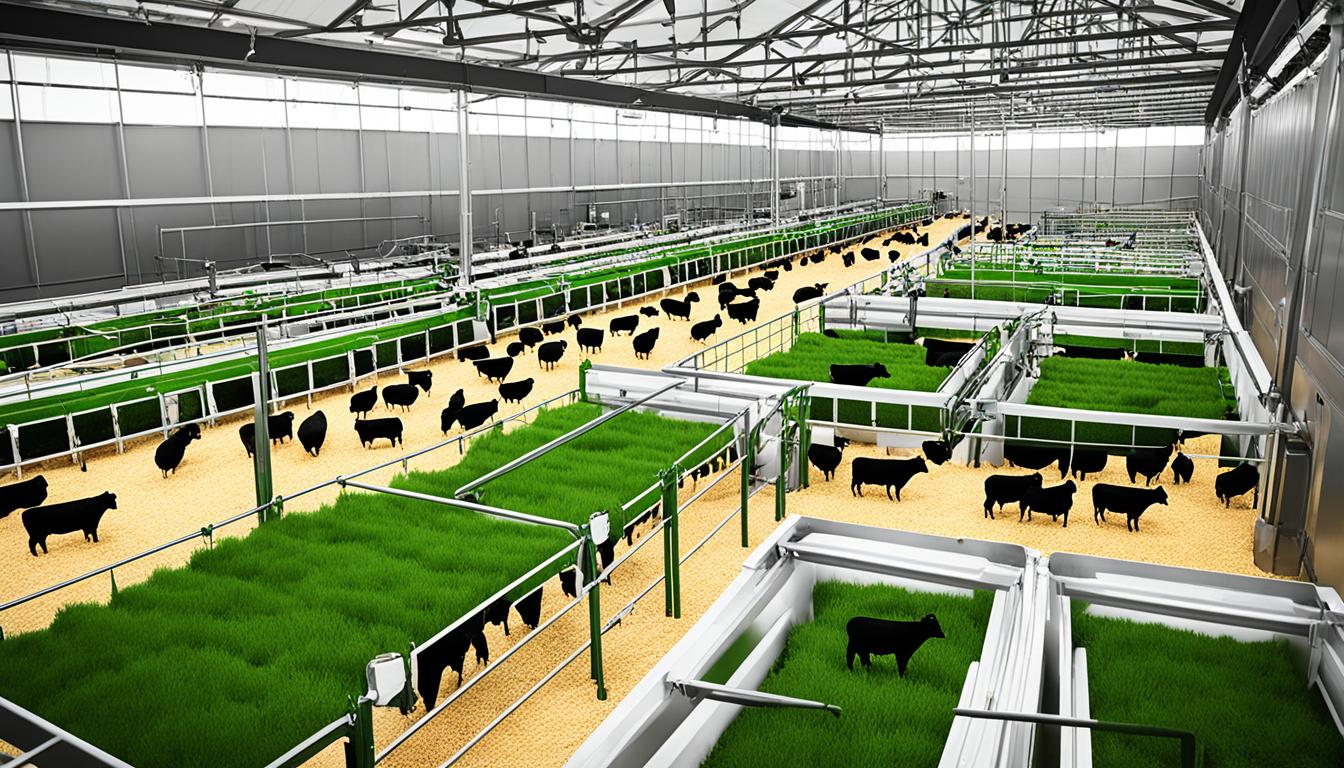
By 2050, the world’s meat production is set to double. This big jump shows the tough job of feeding everyone. But, precision livestock farming (PLF) steps in to help. It uses smart tech to farm better, help the planet, keep us healthy, and care for animals.
Normally, we would expect animal numbers to grow a lot more. For instance, around the world, herds could go up by 46% since 2012. In the UK, however, livestock didn’t increase from 2018 to 2019. Even though fewer people were working on farms. This shows how tech like PLF can help fewer farmers look after more animals well. It does this with real-time systems that watch over the animals and warn farmers if anything’s wrong.
But, PLF’s benefits also come with worries. Some people think that less human and animal contact might make us see animals as objects. And they fear this could change how we care for them. As we get better at farming, we’re also talking more about keeping the link between animals and people strong.
Overall, the world needs PLF. It’s great for the planet and keeps us thinking about how we treat animals. It reminds us to use tech in ways that are still kind.
Precision livestock farming is growing fast because more people need meat and there are fewer farm workers. In the UK, goals like the National Farmers’ Union’s plan for zero emissions by 2040 need new farming tech and smart methods.
In 1983, Dr. Pierre Robert began the work that led to today’s precision farming. He looked at soil differences, starting us on the path to using technology to farm better. By 1992, we had the first tool to track how crop yields changed, helping farmers improve their methods.
GPS systems have been a big step forward in farming precisely. Today, many crops like corn and soybeans are planted with this technology, making sure each part of the field is managed well. With special GPS signals, farmers can do tasks like planting, harvesting, and spraying with pinpoint accuracy.
Farming is being changed a lot by new technology. Systems that track soil and crop data closely have made farming more efficient. But, around 20% of US farms did not have fast internet in 2021. The Precision Agriculture Connectivity Act of 2018 is trying to change that.
There are also important money and loan programs for farmers to get high-tech farming tools. Policies like the Precision Agriculture Loan Program (PAL) Act are helping to spread useful farming tech. These moves show the focus on advancing farming and keeping it eco-friendly, even with new challenges.
Precision Livestock Farming (PLF) has really upped the game in keeping animals healthy. Thanks to animal monitoring technology, farmers can act fast when an animal is unwell. This leads to new and smart solutions to health issues.
Sensors and smart wearables are top choices in monitoring animals’ health. They keep tabs on things like heart rate and activity levels. This info is then sent straight to the farmers. With these tools, the health of animals, like pigs, has greatly improved over the years.
Being able to check animals’ health instantly is a big deal for farmers. They can react quickly to any issues. This quick action helps keep animals healthy and stops diseases from spreading. Real-time monitoring is now a standard in modern farming, all thanks to the work of experts like Berckmans.
Thanks to these new gadgets, dairy animals’ happiness and productivity have gone up, say Simitzis et al. (2022).
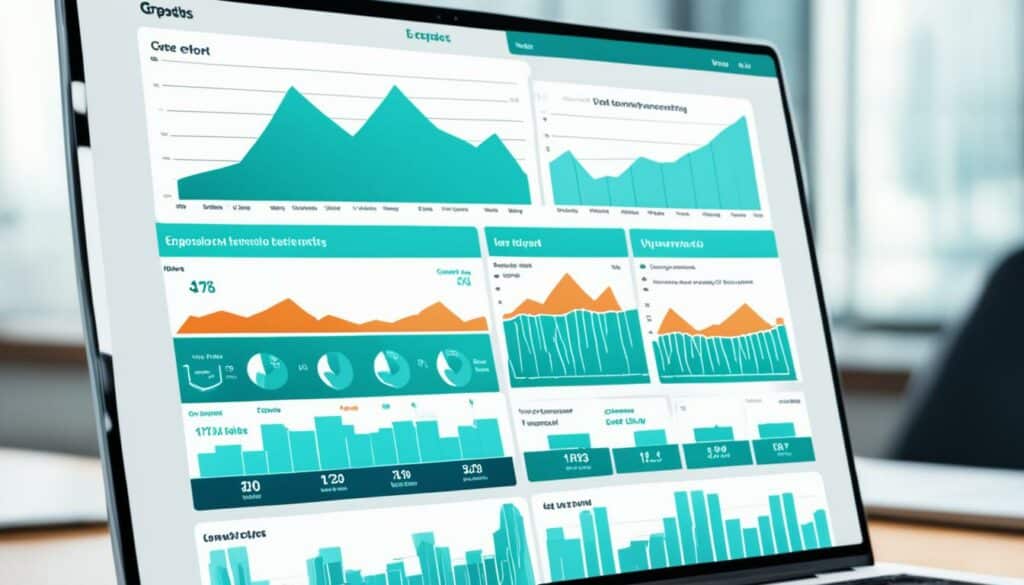
Using wearable technologies in farming does more than just keep animals healthy. It also helps with our big goals in farming: being sustainable and ethical. This way, we can keep up with the world’s food needs without harming our environment or our values.
PLF technologies bring a huge improvement in looking after animals. They use things like sensors, cameras, and the latest in genetics. These tools help meet animals’ needs better, both physically and emotionally.
Studies show how high-tech care lessens animal sickness. For example, new gene editing can make animals more resistant to diseases and boost milk production. It also helps us understand how genes work together. This knowledge can improve animals’ health and metabolic function.
Research points to the benefits of things like probiotics in animal food. Boosting digestion and health, these feed additions make animals stronger against sickness. They improve milk in cows and meat in steer animals. Adding alfalfa to pig feed has also proven to improve their growth and the quality of their meat.
It’s crucial to consider the ethics around using high-tech methods in farming. Some worry about less human-animal connection and whether animals are being used as objects. Technology does help keep a close eye on animal well-being. Yet, we must ensure we don’t lose sight of treating animals with care and respect.
The use of technology in farming doesn’t just make things efficient and healthy. It also calls for us to think deeply about how we treat farm animals. The goal is to have a future where both animals and agriculture thrive, thanks to smart and ethical farming.
| Technologies | Applications | Benefits |
|---|---|---|
| Sensors & Cameras | Real-time monitoring | Early illness detection |
| Genome Editing | Genetic enhancements | Disease resistance, Increased production |
| Probiotics | Feed additives | Improved digestion, Disease resistance |
The need for meat, eggs, and dairy is growing with the world’s population. To keep up, we must boost livestock productivity. Precision livestock farming aims to make farming more efficient. It does this by using technology to control resources and cut costs.
To improve livestock productivity, we must feed animals more precisely. Precision feeding strategies are vital for this. Automated systems monitor animals and give them the right food at the right time. This reduces food waste and helps the environment.
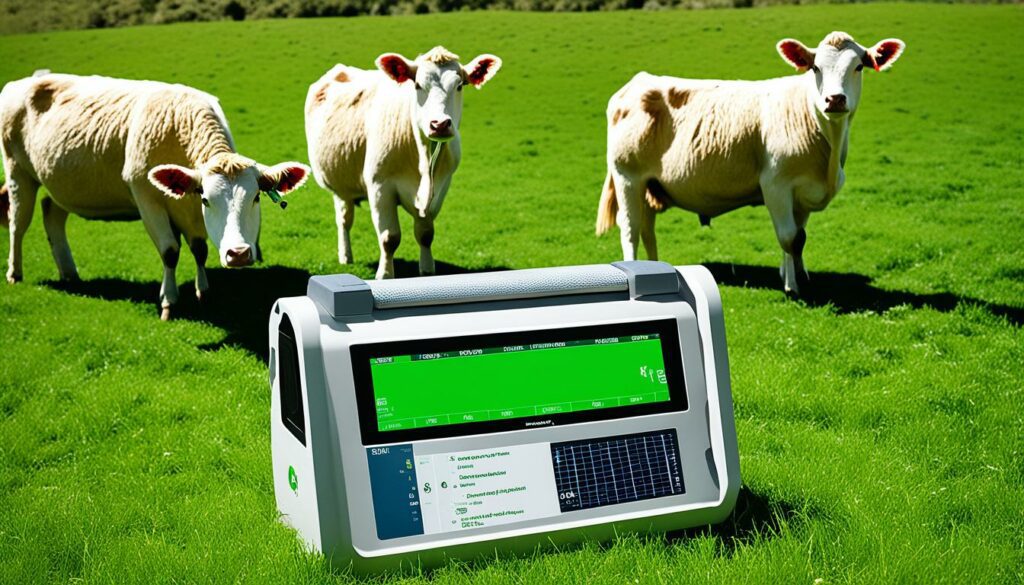
In the United States, technology is changing how farms work. With fewer farmers, we need new methods to keep livestock healthy. These new feeding systems let farmers track growth and behaviour. This helps them make quick, smart decisions about feeding.
PLF also helps cut the costs of farming labour. Automating feeding and health checks means less manual work. This includes GPS for tracking animals and smart IDs. These technologies do jobs that used to need lots of people.
With fewer workers needed, those who are there can look after more animals. This keeps farms running well while saving money. In the US, where farming is a big employer, this tech helps keep jobs secure.
These advances in farming make a big difference. They not only increase production but help the planet. They make sure we can feed the world while keeping farms profitable.
Sustainable livestock farming is vital for tackling today’s environmental issues. With new strategies, we can cut down our impact on the environment. This will help us move towards zero net emissions in farming.
Since 2005, dairy farmer Rob Richmond aimed at improving his pastures. He’s built more carbon in his soils, which makes them stronger and grows more grass. His organic dairy, home to 300 cows on 200 hectares in the UK, uses strip grazing and diverse plants to increase soil health. This helps the soil store more carbon. Such efforts strengthen his fields, making them better equipped for harsh weather and fighting climate change.
Cows that graze outside more also help cut down on harmful ammonia in the air. This shows how daily farm life can help the environment.
To reach the National Farmers’ Union target for a zero emission farm sector by 2040, key steps include sustainable practices. One example is the ‘Grazing cow monitor’ project. It tracks cows with GPS to watch over emissions. In the Azores, research showed that feeding cows more legumes not just boosted milk but also reduced the need for harmful chemicals. This cut the farm’s CO2 output. Also, taking good care of grasslands helps the environment, making farms more diverse and healthier for animals.
The advantage of these methods is clear. They provide a real way forward to a greener and stronger farming future. This solution combines lowering harm to nature with meeting our zero emission goals.
The Internet of Things (IoT) is changing how we farm. By using smart equipment, farmers can track their animals better. This means they can take care of their livestock in a smarter way.
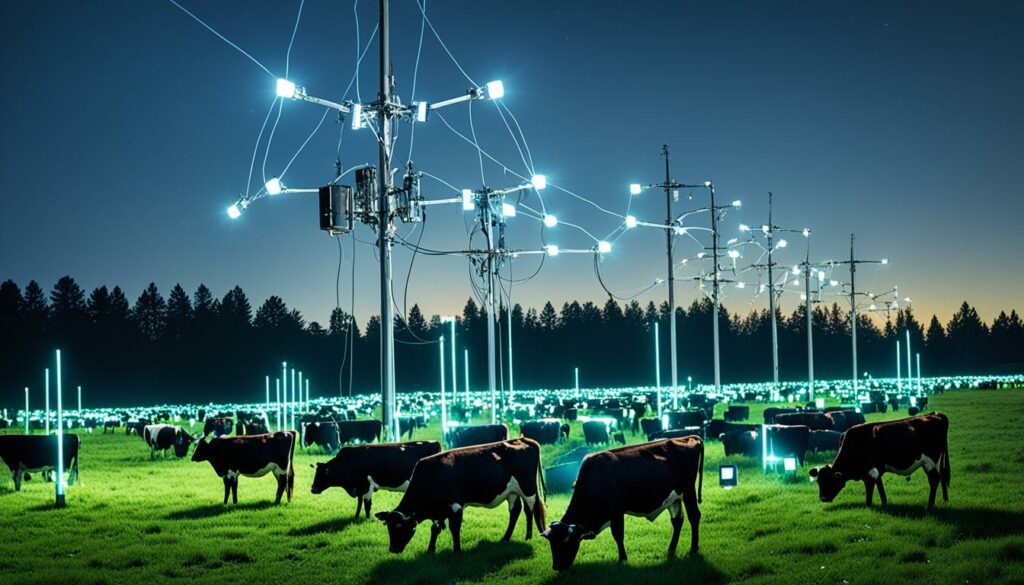
Smart devices are key in handling today’s livestock. They have sensors that watch over animals’ health, where they are, and how they act. By 2016, sensors made up more than half of the technology used in managing livestock. This shows that using these modern tools can make looking after animals much easier.
Real-time data improves how we manage livestock. Farmers get important info about their animals’ health instantly. They can solve issues and make life better for their animals faster. By 2029, the market for this technology will be over 11 billion dollars. This big increase shows how much farmers are starting to rely on data to keep their animals safe and healthy.
Using IoT technology can also save money and make information more accurate. For example, Rapid Innovation has more than 200 experts working on new ways to use technology in farming. This shows that the future of farming is in using smart devices to look after animals well and run farms better.
| Key Statistics | Value |
|---|---|
| IoT Device Market Share (sensors – 2016) | 51% |
| Expected Growth Rate (2022-2029) | 12.1% |
| Market Value by 2029 (USD) | 11.18 Billion |
| Number of Tech Experts at Rapid Innovation | 200+ |
IoT helps farmers be more caring and efficient with their animals. It’s driving a big change towards kinder, smarter ways of farming.
Cattle tracking software is a big step forward in looking after animals today. It helps manage large herds using advanced tech like Precision Livestock Farming. With people wanting more meat, eggs, and dairy as our global numbers grow, this tech is crucial for farms to do well.
This cattle tracking software gives farmers a very clear view of what their animals are doing. They can watch where the animals are, check their health, and study how they act. This helps farmers make quick smart moves to keep their animals healthy and working well. It also catches health problems early, cutting the chance of diseases and making treatments better.
Besides, keeping an eye on the animals helps a lot in keeping them safe from diseases. Seeing their behaviours and health all the time can stop sickness from spreading. This way, farmers can run a safer farm and keep their animals happy and healthy.
Also, using this smart tech can help farmers handle their resources better. They can learn when and what to feed the animals by studying their eating patterns and health. This makes feeding more efficient, less wasteful, and better for the animals. It’s part of a bigger plan to farm smarter, do less harm to the planet, and use resources in the best way.
Putting alerts and reminders in the software means less manual work and fewer mistakes. Vital jobs like giving medicine, feeding, and health checks are done better by machines. This leaves farmers more time to take care of other important farm jobs.
Finally, smart livestock tracking tech means better reports and following rules. It makes detailed reports on the animals’ health and how they’re doing. These reports help with running the farm better, following farming rules, and planning for the future. This detail is key for both day-to-day farm work and looking ahead.
In the end, using cattle tracking software has many benefits. It helps farmers be more in control, keeps animals healthier, and manages farms in ways that are kinder to the earth. This technology is essential for meeting the growing needs of the livestock industry. It’s what will help farmers succeed and keep going strong in the future.
Today’s agriculture sees a big leap in automated livestock systems. The world needs more meat, eggs, and dairy. But, we have less space for farming. So, smart tools are key to farming success globally.
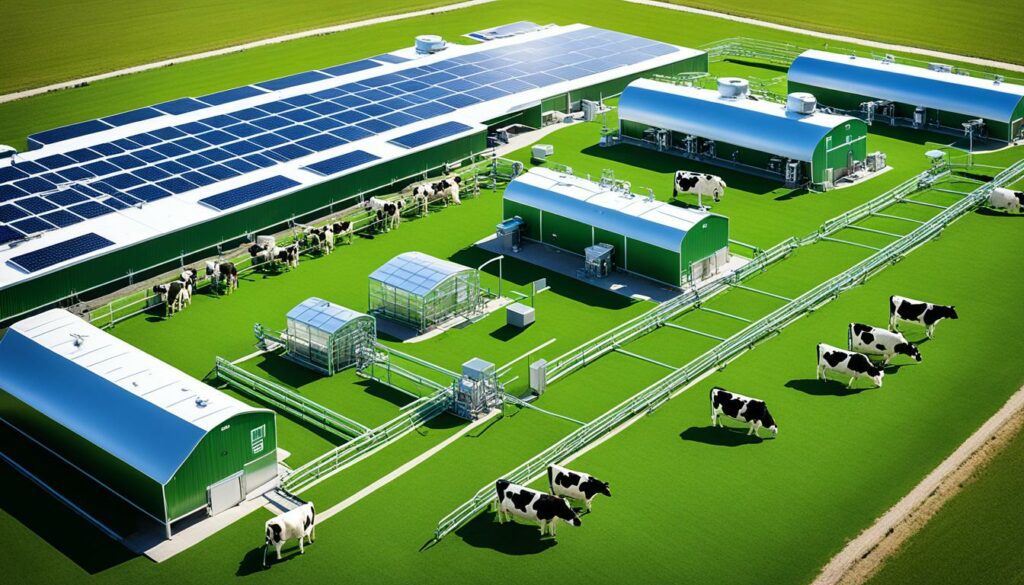
These systems use top-notch tech. From managing feed to milking, they boost farm efficiency. This means farms can run better, watch performance closer, and rely less on people.
Special software helps manage resources and makes farms more productive. It tracks what animals eat, how much they drink, their health, and growth. This tech allows for constant, detailed checks on the animals.
Automated farms do better and need less human work. They include tools like scales for animals, which are easy to use. These systems help sort out animal health and work issues fast. This all makes the farm more profitable.
| Automation Features | Benefits |
|---|---|
| Automated Weighing Systems | Accurate weight measurements |
| Feed & Water Intake Recording | Monitoring with low costs |
| Imaging Solutions (3D, Thermal) | Health analysis |
| Animal Sensing Systems | Behaviour & health monitoring |
| GPS-tracking | Extensive systems monitoring |
| Proxy Technologies (Methane Measurement) | Environmental impact analysis |
| Electronic Identification (EID) Solutions | Accurate animal identification |
| Advanced Data Analytics | Big data insights |
Precision livestock farming helps us make smarter decisions in agriculture. It relies on data-driven farming decisions for a sustainable future. We use smart agricultural data analysis to make key choices in feeding, breeding, and handling diseases.
By using advanced data techniques like machine learning, we can improve farm performance. These methods let us achieve goals such as making more profit and lowering greenhouse gases. This is possible because of advanced technologies in farming.
With more people wanting animal products, farms are getting bigger. But they use fewer farms. Thanks to technologies like machine learning, we can make better decisions. These decisions help us be more sustainable and meet environmental standards.
For example, using heat detectors in dairy farms cut down greenhouse gases by 9.4%. Technology like udder health monitors also reduces harm to the environment. This shows how important data-driven tools are.
Using a mix of optimisation, modelling, and simulations supports decision-making. These help us manage farms in a way that is both profitable and good for the planet. They make our agriculture strong and ready for the future.
Precision livestock farming is changing how farmers and animals interact. With technology like automatic milking and robotic feeding, the way farmers care for their animals changes.
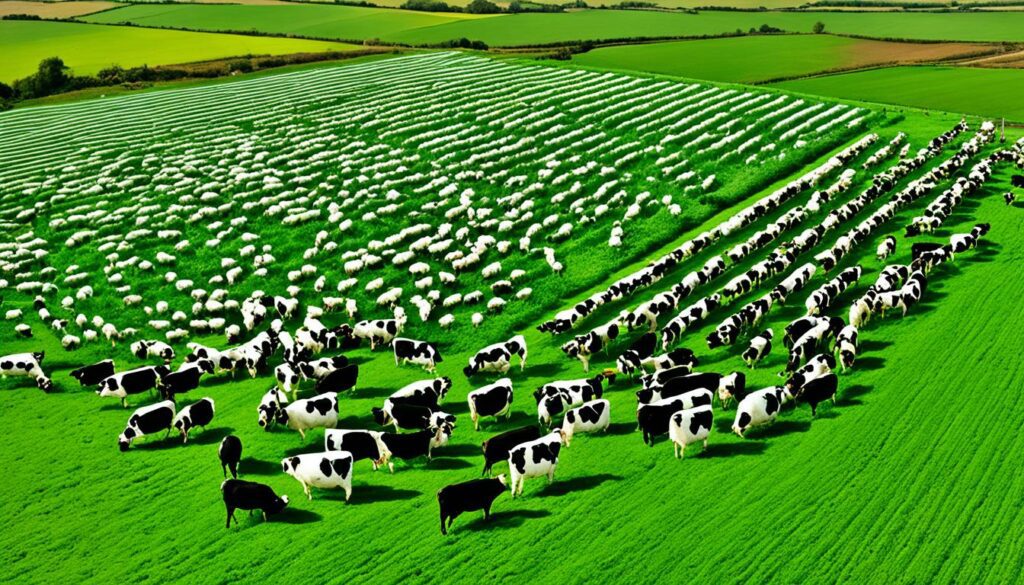
These new tools make farming more efficient. Farmers can now spend less time on repetitive tasks. Some worry this might affect how friendly and close the animals are with people.
For example, using robots in milking means farmers don’t have to be in the barn as often. This cuts down on the time spent together, affecting their bond.
The use of these tools also sparks important ethical debates. With less need for direct care, the connection between farmers and their animals might weaken. It begs the question if animals are seen more as tools for production than living beings.
While these technologies help manage farms better, they risk making animals just parts of a business. This worries some farmers. They are concerned about losing the personal and attentive care to their animals, which are essential in farming.
A study looked at 25 French farms, trying to understand how PLF affects their work. It found that farmers fall into one of three categories:
| Profile | Views on Human-Animal Relationship | Adoption of PLF Technologies |
|---|---|---|
| Profile A | Maintains strong direct contact with livestock, practices relational methods | Low adoption, cautious about automation |
| Profile B | Balances technological benefits with maintaining interaction | Moderate adoption, uses selective PLF tools |
| Profile C | Highly reliant on automated systems, minimal direct interaction | High adoption, embraces full automation |
These profiles show different viewpoints in farming. While technology has good points, it’s key to think about how it affects the relationship between farmers and animals, and the ethics of farming.
Precision livestock farming (PLF) offers a lot, but not everyone can use it easily. It costs more for small and medium farmers. The biggest issues are the setup cost and how much it takes to keep it running. About 60% of those in farming see the tools needed as too expensive. For those who haven’t started using it, the main reason is still the cost.
The price tag for PLF is high. It goes from gadgets to systems in the cloud that need yearly payments. For instance, tools like GPS to help guide work have become more popular. Still, they are hard to afford. Even though some farmers use these technologies, others can’t because they’re too expensive.
Farmers worry about rules that might change. They don’t want to buy things for their farms if they might not be allowed to use them later. It’s vital that the rules are clear and help farmers use smart technology. This way, farmers would feel more certain and willing to invest in high-end tools.
Different farmers use new tools at different rates. This can depend on how big their farm is and how much they know. The lesson? Make support that fits the needs of many kinds of farmers. Support is important for everyone, no matter their background or farm size.
Good internet is key for using these smart tools together. Sadly, not all farms have this yet. Along with internet, farmers worry about keeping their information safe. They don’t want to lose control of their important data.
| Barrier | Impact |
|---|---|
| High Investment Costs | 60% of producers find equipment and services too expensive |
| Agricultural Policy Uncertainty | Farmers hesitant to commit due to lack of regulatory clarity |
| Data Privacy | Concerns over data ownership and confidentiality |
| Rural Broadband Access | Limited internet availability affects technology interoperability |
Precision Livestock Farming (PLF) has become a hot topic. This is thanks to many successful case studies in precision farming. One key study is by Bucci et al. (2018). It showed how using precision agriculture can make farming more sustainable. This points out the big change PLF technology can bring to making farming sustainable.
The European Commission’s 2017 report discussed the benefits of precision farming. It talked about the EU’s support for this technology. It also showed how studies, like those by Higgins et al. (2019), highlight the benefits of PLF on farms in the UK and Ireland. This includes better soil management due to PLF technology.
IoT and UAV technologies have made big improvements in farming. A study by Boursianis et al. (2020) looked at how these technologies help monitor livestock health. They make farming more productive and take better care of animals and workers.
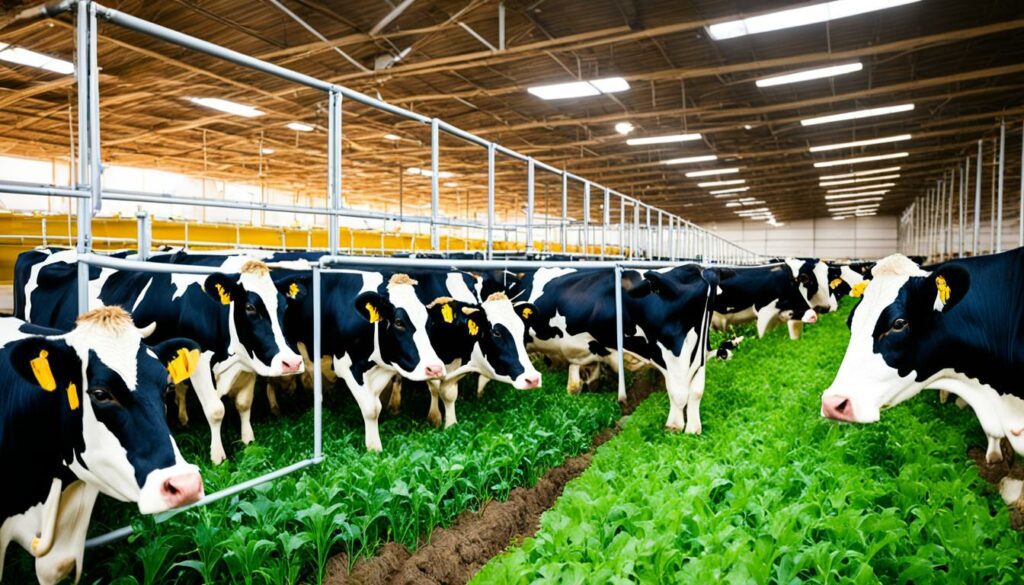
Studies like the one by Lakhankar et al. (2009) have shown the benefits of advanced soil moisture analysis. Others, like Goap et al. (2018), have proven the usefulness of precision irrigation. New tech, such as the one for spreading fertiliser from drones (Song et al., 2021), are also making huge strides in farming.
These examples show how sensors and IoT can make farming better in many ways. They boost farm output, take better care of animals, and make the farm run smoother. Both industry and scientific studies agree how important PLF is for the future of farming around the world.
Introducing precision livestock farming marks a huge step forward in agriculture. It will boost animal care, help the environment, and make farms more efficient. This new way of farming uses high-tech equipment and science to control diseases better, making farming smarter around the world.
The use of high-tech gadgets and drones in farming shows big improvements, especially in Europe. These tools help farmers work better, grow more food, and look after the land. They also use space-age tech to check soil health, a key part of farming well.
Of course, getting into this kind of farming isn’t easy and costs a lot. But, the good it does is big. It helps manage big loads of data and improves the way we look after animals. These new tools also help in the fight against climate change by cutting greenhouse gas emissions.
To make this new farming future a reality, everyone needs to join in. Farmers, tech experts, and those making the rules must work together. This push for smarter farming will surely lead to a better future in agriculture. Livestock farmers have a lot to look forward to in how they care for their animals.
Precision livestock farming brings many benefits. It helps monitor animal health and welfare. It also boosts productivity and supports the environment. Farms use sensors, cameras, and data analysis for better decisions. This leads to more efficient farms.
Precision livestock farming has grown with new tech like IoT devices and wearables. These help farmers closely watch and manage their animals. They meet the needs of the meat industry and care for the environment better.
Sensors and wearables are key to tracking animal health. They collect data on things like heart rate and movements. Farmers get alerts based on this data, helping them care for their animals better.
Technology makes sure animals are always looked after. It responds quickly to any problems, making sure animals are happy, comfortable, and can act naturally. But, can we rely too much on technology when it comes to taking care of animals?
Precision farming boosts productivity. It uses health data to feed animals just right, cutting waste. Automation also reduces the need for extra work. Overall, farms run smoother and use resources better.
PLF helps the planet by lessening the bad effects of farming. It uses resources wisely and keeps animals healthy. This fits with Environmental targets like the National Farmers’ Union’s zero emissions goal for 2040.
IOT brings smart devices to farming, blending new and old ways. This setup collects lots of data for better decisions. It helps farmers manage their livestock smarter and more effectively.
Cattle tracking software is a big help. It tracks where cattle are, checks their health, and studies how they behave. This information lets farmers look after their herds better, keeping them healthy and safe.
Automated farming uses different software, like for feeding and milking. These tools make farms work better, lessen manual work, and go digital. They are a big part of modernising farms.
Data helps farmers make smarter choices. It comes from tech on the farm. It guides decisions on what to feed, which animals to breed, and how to fight diseases. This way, farms work better and are kinder to the environment.
PLF changes how farmers interact with animals. They rely less on direct care because of automatic tools. This makes us think about the way we care for and see animals.
The main hurdles are the high cost to start and not knowing what farming policies will be. This makes some farmers hold back from using new tech. They need more reasons and rules to jump in.
Many stories show how successful PLF can be. They point to better farm work, animal care, and how tech can help. These include success with smart sensors, IOT, and using data well.